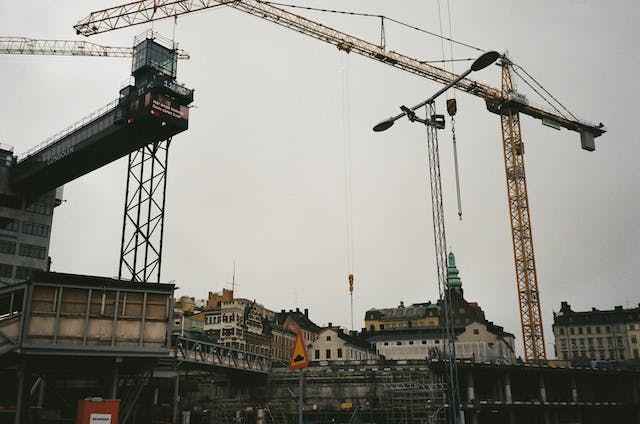Crane operators have a few bathroom options while on the job.
Some cranes are equipped with portable restrooms in the workspace, allowing operators to use the facility without causing delays in their work.
In other cases, crane operators may use a funnel inside the cab that is attached to a tube, which drains waste into a portable toilet attached to the side of the crane’s mast.
Alternatively, some crane operators may use a 20-litre drum or an empty water jug to collect urine during their shift.
Understanding Crane Operator Work Environment
In the elevated cabins where crane operators execute their tasks, space is limited, and conditions are confined. These professionals work with continuous focus, often with minimal breaks.
Exploring this unique work environment sheds light on the challenges they encounter daily.
Challenges Faced by Crane Operators
Limited Accessibility
Accessing traditional bathroom facilities poses a significant challenge for crane operators due to the height and inaccessibility of their workstations.
This limitation not only affects their work efficiency but also raises safety concerns.
Nature of the Job
The unpredictable nature of crane operations makes it challenging for operators to take extended breaks for basic needs such as using the bathroom.
This aspect adds an extra layer of complexity to their already demanding job.
Solutions Explored by Crane Operators
Portable Facilities
To overcome the accessibility challenge, crane operators often resort to using portable bathrooms within their cabins. While this solution provides convenience, it comes with its set of pros and cons that need careful consideration.
Scheduled Breaks
Crane operators strategically plan bathroom breaks during scheduled downtime. Navigating the balance between fulfilling work demands and personal needs requires careful planning to ensure smooth operations.
Innovations in Crane Operator Facilities
Crane Cabin Design
Advancements in crane cabin design focus on improving operator comfort, including the integration of bathroom facilities within cabins. This innovation aims to enhance the overall working experience for crane operators.
Technological Solutions
The exploration of technology-driven solutions for sanitation in crane cabins opens up possibilities for improved facilities. Looking into the future, these innovations could significantly contribute to the well-being of crane operators.
FACTS ABOUT CRANE OPERATING and OPERATORS

Are Portable Restrooms Commonly Available In Most Cranes Or Only In Specific Types Of Cranes?
Portable restrooms are commonly available in cranes.
Crane operators use portable toilets.
Some companies offer crane lift restrooms that can be lifted safely to hard-to-reach locations such as roofs.
Some portable restrooms are designed exclusively for high-rise applications and can be hoisted by crane or sling.
Some portable restrooms are also ADA-compliant, providing easy wheelchair entry and user-friendly interior handrails.
How Frequently Are The Portable Restrooms Or Waste Collection Systems Emptied Or Serviced For Crane Operators?
There is no information available on how frequently portable restrooms or waste collection systems are emptied or serviced for crane operators.
However, it is mentioned that toilets have been installed for the convenience of crane operators.
The number of portable restrooms that can be serviced in a day depends on various factors such as location, number, setup, and capacity of pumper trucks.
Do Crane Operators Have Designated Breaks Or Downtime To Use The Bathroom, Or Can They Go Whenever Necessary?
It appears that there are no federal regulations that require employers to provide bathroom breaks for crane operators.
However, some employers may allow operators to take breaks as needed, while others may require them to stay in the crane for the majority of their shifts.
In Philadelphia, a new bill is being considered that would require tower crane operators to be given breaks of at least 30 minutes every four hours and allow them to leave the crane for restroom breaks at any time.
It is important to note that the laws and regulations regarding bathroom breaks for crane operators may vary depending on the location and employer.
Are There Any Safety Concerns Or Guidelines Regarding Using Portable Restrooms Or Waste Collection Systems In Cranes?
There are several guidelines and regulations regarding the use of portable restrooms or waste collection systems in cranes.
OSHA requires employers to provide all workers with sanitary and immediately-available toilet facilities (restrooms) .
The sanitation standards are intended to ensure that workers do not suffer adverse health effects that can result if toilets are not sanitary and are not available when needed.
ANSI Z4.3 guidelines specify that there should be 1 toilet for every 10 males and 1 for every 10 females.
However, there are no specific guidelines for the placement of portable toilet facilities or the particular type of facility that should be used.
While there are no specific regulations regarding the use of portable restrooms or waste collection systems in cranes, investing in portable restrooms is a great way to keep employees happy and reduce wasted time and resources.
Are There Any Challenges Or Limitations In Using A Funnel And Tube System Inside The Crane’s Cab For Waste Disposal?
There are some related search results that provide information on waste management and disposal.
For example, one discusses the benefits and drawbacks of pneumatic waste systems.
Another provides a guide for commercial buildings on managing and reducing waste, including establishing a waste reduction program and increasing recycling to cut disposal costs.
It is important to note that the use of a funnel and tube system for waste disposal inside a crane’s cab may have specific challenges and limitations that are not addressed in these search results.
It is recommended to consult with waste management professionals or crane manufacturers for more information on this topic.
FAQ
Q1: Can crane operators leave their cabins during work hours?
Crane operators typically remain in their cabins during work hours due to the nature of their tasks, requiring constant attention and focus.
Q2: Are there specific regulations for crane operator facilities?
Yes, regulations exist to ensure appropriate facilities for crane operators, but there is room for improvement in many cases.
Q3: Do all cranes have bathroom facilities in their cabins?
Not all cranes have integrated bathroom facilities, and this varies depending on the design and purpose of the crane.
Q4: How do technological solutions improve the working conditions for crane operators?
Technological solutions, such as integrated bathroom facilities and advanced cabin designs, contribute to better working conditions for crane operators by addressing their unique challenges.
Q5: What are the challenges of accessing traditional bathroom facilities for crane operators?
The primary challenge lies in the height and inaccessibility of crane cabins, making it impractical for operators to access traditional bathroom facilities during their work shifts.
Conclusion
Recapping the challenges and solutions discussed emphasizes the importance of supporting and understanding the unique needs of crane operators. A call to action encourages further efforts in creating a conducive work environment for these essential professionals.







